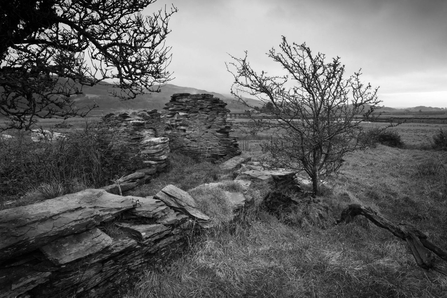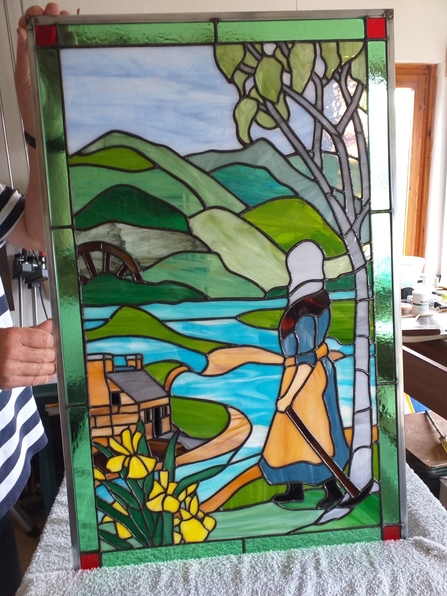The ruin of Tŷ Maenan is on a rocky outcrop near the present day railway bridge across the Dyfi River. The remains have been mapped by archeologists and there are written accounts of the house being used as a 'tafarn' or pub by sailors who were waiting for the next hightide to carry their boats to Derwenlas. The sailors would drop anchor in Llyn Draenog, a deep pool on the bend of the river and then row in small boats across to Tŷ Maenan for a beer or two.

Low stone walls are all that remain of this house near the river. On high, spring tides it would have been almost surrounded by water.
Records from the 1850s show that the house was owned by Mary Jones who lived there with her daughters. They ran the 'tafarn' and lived in the house.

Stained glass artists Annie and Stephen Sage have created this wonderful window for us,
The artists themselves describe this window as follows:
'This stained glass panel reflects some aspects of the landscape around the Dyfi River, although it is not intended to portray any particular place in detail. The figure is that of a working woman of the 19th Century with the typical hard-wearing and serviceable clothes of the time: dark skirts, shawls in natural colours of grey, brown or black, small, tightly bound head-scarves, large aprons sometimes made of sacking, and stout black boots.
Along with the men who worked and shaped this landscape women also worked in its industries, its agriculture and its homes. Many women would have kept their families alive - working every moment to get pocket money while the men were absent at sea, in mines or quarries. Some of them, especially pre-marriage, worked in heavy industry and agriculture and rural women were (perhaps secretly) well regarded as hard workers.
Maybe you could think of the figure as that of Mary Jones who lived with her two daughters at Tŷ Maenan, just a few hundred metres from the Dyfi osprey nest, in the 1850s and sold beer and food to the sailors of ships and boats heading up the river.
Or maybe she represents the spirit of the place, the timeless yet continual interaction of humans within a landscape and its environment, shaping, changing, and nurturing, close to land and water, stone and weather, plant and creature - and no stranger to hard work.'
We obviously like to think of her as Mary Jones of Tŷ Maenan.
This will be installed above the door of the Cwtch Brethyn. Thank you so much, Annie and Stephen.